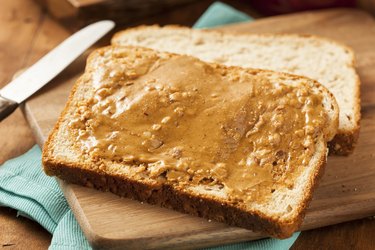
When you eat foods -- peanut butter or anything else -- you break down the large nutrient molecules the foods contain into smaller molecules. Your small intestine absorbs these into the bloodstream. The process of digestion starts in your mouth and continues as food progresses all the way through to the small intestine.
Peanut Butter
Video of the Day
Peanut butter contains a mixture of all three macronutrient molecules: carbohydrates, protein and fat. Carbohydrates include sugars and starch, as well as fiber, which is indigestible. There are also vitamins and minerals in peanut butter, but you don't digest those, despite the fact that they're an important part of peanut butter's nutrition. Instead, you absorb the vitamins and minerals whole. Fiber, on the other hand, passes undigested thorough your gut.
Video of the Day
Carbohydrate Digestion
The digestion of some components of peanut butter starts early -- while you're still chewing your food. Enzymes called amylases break down starch, explain Drs. Reginald Garrett and Charles Grisham in their book "Biochemistry." You secrete an amylase -- called salivary amylase -- as part of your saliva. This enzyme begins working right away, and partially converts the starch in peanut butter into smaller molecules, which are sugars. You don't chew food long enough to convert all the starch into sugar, however.
Protein Digestion
You continue the process of digesting peanut butter in the stomach. Gastric juices contain acid, water and a variety of enzymes. These continue digesting starch, and also begin the process of breaking down protein. Starch and protein digestion are very similar in many ways. In both cases, enzymes assist water and acid in breaking the bonds between small building block molecules held together in long chains by a series of bonds.
Fat Digestion
In your large intestine, you complete the processes of starch and protein digestion, you digest certain sugars and you also begin digesting fats. Peanut butter contains a fair amount of fat; it varies depending upon the type of peanut butter and the way it's made, but it's always a significant percentage of the composition. To digest fat, your small intestine uses both enzymes and emulsifying agents called bile salts. The bile salts help the fats mix with water-based digestive juices, explains Dr. Lauralee Sherwood in her book "Human Physiology."